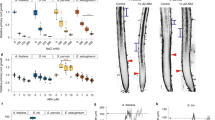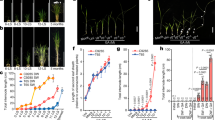Abstract
Changing environmental conditions and lessening fresh water supplies have sparked intense interest in understanding and manipulating abscisic acid (ABA) signaling, which controls adaptive responses to drought and other abiotic stressors. We recently discovered a selective ABA agonist, pyrabactin, and used it to discover its primary target PYR1, the founding member of the PYR/PYL family of soluble ABA receptors. To understand pyrabactin's selectivity, we have taken a combined structural, chemical and genetic approach. We show that subtle differences between receptor binding pockets control ligand orientation between productive and nonproductive modes. Nonproductive binding occurs without gate closure and prevents receptor activation. Observations in solution show that these orientations are in rapid equilibrium that can be shifted by mutations to control maximal agonist activity. Our results provide a robust framework for the design of new agonists and reveal a new mechanism for agonist selectivity.
This is a preview of subscription content, access via your institution
Access options
Subscribe to this journal
Receive 12 print issues and online access
$189.00 per year
only $15.75 per issue
Buy this article
- Purchase on Springer Link
- Instant access to full article PDF
Prices may be subject to local taxes which are calculated during checkout




Similar content being viewed by others
References
Nambara, E. & Marion-Poll, A. Abscisic acid biosynthesis and catabolism. Annu. Rev. Plant Biol. 56, 165–185 (2005).
Cutler, S., Rodriguez, P.L., Finkelstein, R.R. & Abrams, S.R. Abscisic acid: emergence of a core signaling network. Annu. Rev. Plant Biol. 61, 651–679 (2009).
Wang, Y. et al. Molecular tailoring of farnesylation for plant drought tolerance and yield protection. Plant J. 43, 413–424 (2005).
Rademacher, W., Maisch, R., Liessegang, J. & Jung, J. Water consumption and yield formation in crop plants under the influence of synthetic analogues of abscisic acid. in Plant Growth Regulators for Agricultural and Amenity Use Vol. 36 (eds. Hawkins, A.F., Stead, A.D. & Pinfield, N.J.) 53–66 (British Crop Protection Council Publications, Thornton Heath, London, 1987).
Park, S.Y. et al. Abscisic acid inhibits type 2C protein phosphatases via the PYR/PYL family of START proteins. Science 324, 1068–1071 (2009).
Iyer, L.M., Koonin, E.V. & Aravind, L. Adaptations of the helix-grip fold for ligand binding and catalysis in the START domain superfamily. Proteins 43, 134–144 (2001).
Szostkiewicz, I. et al. Closely related receptor complexes differ in their ABA selectivity and sensitivity. Plant J. 61, 25–35 (2010).
Ma, Y. et al. Regulators of PP2C phosphatase activity function as abscisic acid sensors. Science 324, 1064–1068 (2009).
Santiago, J. et al. The abscisic acid receptor PYR1 in complex with abscisic acid. Nature 462, 665–668 (2009).
Nishimura, N. et al. Structural mechanism of abscisic acid binding and signaling by dimeric PYR1. Science 326, 1373–1379 (2009).
Miyazono, K. et al. Structural basis of abscisic acid signalling. Nature 462, 609–614 (2009).
Yin, P. et al. Structural insights into the mechanism of abscisic acid signaling by PYL proteins. Nat. Struct. Mol. Biol. 16, 1230–1236 (2009).
Melcher, K. et al. A gate-latch-lock mechanism for hormone signalling by abscisic acid receptors. Nature 462, 602–608 (2009).
Volkman, B.F., Lipson, D., Wemmer, D.E. & Kern, D. Two-state allosteric behavior in a single-domain signaling protein. Science 291, 2429–2433 (2001).
Melcher, K. et al. Identification and mechanism of ABA receptor antagonism. Nat. Struct. Mol. Biol. doi:10.1038/nsmb.1887 (published online 22 Aug 2010).
Yuan, X. et al. Single amino acid alteration between valine and isoleucine determines the distinct pyrabactin selectivity by PYL1 and PYL2. J. Biol. Chem. doi:10.1074/jbc.M110.160192 (published online 14 July 2010).
Otwinowski, Z. & Minor, W. Processing of X-ray diffraction data collected in oscillation mode. Methods Enzymol. 276, 307–326 (1997).
Frederick, R.O. et al. Small-scale, semi-automated purification of eukaryotic proteins for structure determination. J. Struct. Funct. Genomics 8, 153–166 (2007).
McCoy, A.J., Grosse-Kunstleve, R.W., Storoni, L.C. & Read, R.J. Likelihood-enhanced fast translation functions. Acta Crystallogr. D Biol. Crystallogr. 61, 458–464 (2005).
Storoni, L.C., McCoy, A.J. & Read, R.J. Likelihood-enhanced fast rotation functions. Acta Crystallogr. D Biol. Crystallogr. 60, 432–438 (2004).
Emsley, P. & Cowtan, K. Coot: model-building tools for molecular graphics. Acta Crystallogr. D Biol. Crystallogr. 60, 2126–2132 (2004).
Painter, J. & Merritt, E.A. Optimal description of a protein structure in terms of multiple groups undergoing TLS motion. Acta Crystallogr. D Biol. Crystallogr. 62, 439–450 (2006).
Painter, J. & Merritt, E.A. TLSMD web server for the generation of multi-group TLS models. J. Appl. Crystallogr. 39, 109–111 (2006).
Collaborative Computational Project, Number 4. The CCP4 suite: programs for protein crystallography. Acta Crystallogr. D Biol. Crystallogr 50, 760–763 (1994).
Davis, I.W. et al. MolProbity: all-atom contacts and structure validation for proteins and nucleic acids. Nucleic Acids Res. 35, W375–W383 (2007).
Laskowski, R.A., MacArthur, M.W., Moos, D.S. & Thornton, J.M. PROCHECK—a program to check the stereochemical quality of protein structures. J. Appl. Crystallogr. 26, 283–291 (1993).
Moriarty, N.W., Grosse-Kunstleve, R.W. & Adams, P.D. electronic Ligand Builder and Optimization Workbench (eLBOW): a tool for ligand coordinate and restraint generation. Acta Crystallogr. D Biol. Crystallogr. 65, 1074–1080 (2009).
Vidal, M., Brachmann, R.K., Fattaey, A., Harlow, E. & Boeke, J.D. Reverse two-hybrid and one-hybrid systems to detect dissociation of protein-protein and DNA-protein interactions. Proc. Natl. Acad. Sci. USA 93, 10315–10320 (1996).
Acknowledgements
S.R.C. thanks Jeffrey Bachant (Univ. of California, Riverside) for sharing yeast strains. This work was supported by the US National Institute of General Medical Sciences Protein Structure Initiative (U54 GM074901) and the US National Science Foundation (IOS-003725-002). We acknowledge the Life Sciences Collaborative Access Team at sector 21 at the Advanced Photon Source at Argonne National Laboratory for X-ray beamline access.
Author information
Authors and Affiliations
Contributions
F.C.P., E.S.B. and C.A.B. solved crystal structures; S.-Y.P. performed assays and carried out cloning of ABA receptors and mutagenesis studies; J.J.W. performed NMR analysis; D.R.J. purified proteins and contributed to crystallization screening; C.-A.C. performed modeling studies; G.N.P., S.R.C. and B.F.V. supervised the work, interpreted data and contributed to the writing of the manuscript.
Corresponding authors
Ethics declarations
Competing interests
S.R.C. holds a related patent application; the S.R.C. laboratory receives research funding from Syngenta.
Supplementary information
Supplementary Text and Figures
Supplementary Figures 1–3 and Supplementary Table 1 (PDF 462 kb)
Rights and permissions
About this article
Cite this article
Peterson, F., Burgie, E., Park, SY. et al. Structural basis for selective activation of ABA receptors. Nat Struct Mol Biol 17, 1109–1113 (2010). https://doi.org/10.1038/nsmb.1898
Received:
Accepted:
Published:
Issue Date:
DOI: https://doi.org/10.1038/nsmb.1898
This article is cited by
-
An orthogonalized PYR1-based CID module with reprogrammable ligand-binding specificity
Nature Chemical Biology (2024)
-
Rapid biosensor development using plant hormone receptors as reprogrammable scaffolds
Nature Biotechnology (2022)
-
Genome-wide identification of ABA receptor PYL/RCAR gene family and their response to cold stress in Medicago sativa L
Physiology and Molecular Biology of Plants (2021)
-
Genome-wide identification and characterization of ABA receptor PYL/RCAR gene family reveals evolution and roles in drought stress in Nicotiana tabacum
BMC Genomics (2019)
-
Structural determinants for pyrabactin recognition in ABA receptors in Oryza sativa
Plant Molecular Biology (2019)



